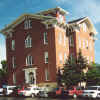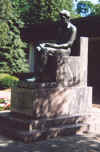"I will hunt you down until you cease to haunt my eyes with hunger. I heard your foot-falls in the desert, I saw your shadow in old buried places, I heard your laughter running down a million streets, but I did not find you there. . . . But in the city of myself, upon the continent of my soul, I shall find the forgotten language, the lost world, a door where I may enter, and music strange as any ever sounded. . . ."
Thomas Wolfe, Look Homeward, Angel
* * * * *
Introduction
On Thursday morning, July 12, 2001, I drove from Pekin, where my wife's parents live, to Lincoln to visit my father, Darold Henson, and stepmother, Judy Henson. I turned off Route 155 onto Route 136, from where I turned south on Nicholson Road.
When I got to the old Union Station, I got the idea of taking some pictures of places/things I had remembered from youth. Driving into Lincoln, I continued to snap locations as I passed Lincoln College, where I attended my freshman year (1960-61), and entered downtown. From there, I went to LCHS in search of Mr. Bass's memorial tree and plaque, which I had not seen for many years. Then, I drove toward Lincoln Lakes, turning onto West Kickapoo, where my Jefferson School classmate Bradley Fox's family had lived when his father, William Fox, M.D., was superintendent of the Lincoln State School. Then I went past the old Mill tavern and restaurant before reaching Dad and Judy's house.
Later, as I headed back toward Pekin, I returned to the downtown to shoot the lights on the marquee of the Lincoln Theatre and then, driving toward the Interstate, I took pictures of the Logan County Fairgrounds and the remains of the Blu-Inn/Heritage Inn.
Below are the pictures I got. Some are of poor quality. I was using a throw-away camera, and sometimes the side of the building I wanted to shoot had the sun behind it. The tour, a mini-pilgrimage, was all too brief and limited; but I wanted to have pics of some special places to help me remember them till next time, or in case there is no next time either for the places or for me.
* * * * *
As on the Web page containing the Roy Rogers'
Riders Club photos, here I use "thumbnail" photos to allow for
nearly instantaneous page loading. Simply click on the "thumbnail" photos to enlarge them.
Nicholson Road
* * * * *
* * * * *
Lincoln College
* * * * *
Warning to out-of-town alums seeking tennis courts to challenge their in-town counterparts: the tennis courts across the street from the sculpture are now defunct, with surrounding fence and center-court net removed and court surface crumbling (more progress?).
The statue reminds me of a story about Raymond Dooley, long-time president of Lincoln College, and great promoter of Lincoln lore and the Centennial (1953). He had been a student at Harvard (and LC students--and the rest of the town-- thought he had a doctorate from there. It turned out he had only an honorary doctorate from somewhere else, I believe). The story is that, as a student, a somewhat tipsy Mr. Dooley had climbed up to sit in the lap of the Lincoln statue at the Lincoln Memorial in Washington, D.C.
My only other RD story: one hot p.m. in the mid '60s in Gordon's Tap, next to the Colonial Restaurant, I was enjoying a 15-cent cold Schlitz draft when a car pulled up to the front door; and distinguished RD, with cane, noisily banged his way into the common man's pub. He consumed a shot of whiskey and then ambled out the door just in time for his driver to pick him up after circling the block. Timing is everything!
* * * * *
Immediately west of Harts' Hall is another college residential building (cannot recall the name) used for faculty apartments in later years. Another English teacher, Mrs. Lois Hall, lived there (she lived on 7th St. when I was an LC student). She was from New England and was my freshman composition teacher and not my favorite. She evaluated writing based mainly on the quality of comma usage, and at that time, I had not gained much proficiency with it. Also, her voice was so soft I could not hear it from the back row, where I preferred to sit in semi-anonymity (before I gained studenting skills).
Lincoln Downtown Area
The landmark Carnegie Library can be seen in the background to the right. The library now has a scanner, thanks to the benevolence of Fred Blanford.
* * * * *
* * * * *
In the early 1950s, my father took me to see various films, including The Thing at the Grand, where I remember James Arness as "the thing" had women screaming at the top of their lungs. Also, see https://lincolnhigh1960.tripod.com/rrrc.html for Mr. Paul Million and the Lincoln Theatre Roy Rogers' Riders Club photos and members' stories.
* * * * *
Another time, I remember an aunt and uncle leaving from the train station to go on their honeymoon. I had been given a bag of rice for throwing. Cautiously, I grabbed one handful and took the bag over to the wall to store it there for re-loading; but when I returned, another aunt had snatched it up and, oblivious to my pleading, was emptying my sack.
* * * * *
Site of Dial and Jones's, then Dial's,
Texaco Station at Fifth and Union. Harry Dial and "Putz" Jones
had been IL state troopers. Harry liked to tell a story of how he
once pulled "Squire" Scully over on Rte. 66. This station
was patronized by local politicos, business folk, elderly ladies who
needed a competent oil change (Dial drained the oil for 20 minutes to
remove as much debris as possible), and dozens of young guys, who found access
to vending machines with cigarettes, candy bars, and Cokes. Dial
cautiously allowed teen guys to borrow tools and wash cars, and the station was a
sanctuary where they could go watch tv without having to see Lawrence
Welk. I believe Diers has a story about Classmate Mike Berry trying
to drop a lighted match into the open pipe of an underground gas tank.
The tree near the alley where we carved our names is gone.
His "guys" in later years secretly
bought him a new desk and office chair (got a good deal from Thudium's
Lincoln Office). While Dial was at dinner, the new
furniture was installed, and the old pieces were placed on the big curb
out front, chair stacked on top of the desk. We had the hired man,
Wayne Charron, call Dial to tell him he had better come down to the
station right away as there was trouble. Harry, arriving, seeing the
furniture, and knowing his
office had been "vandalized," pulled onto the middle of the
drive in his old blue truck, stopped, got out, and entered his station
with a very red, angry face. Then, amazed, he saw his new office,
and Pete Ross asked him, "Now that you like 'em, do you want to
buy 'em?"
LCHS
As I recall, some folks in the first class to graduate from the new campus ('59) tried to continue the tradition of painting numerals on the chimney, but the practice was not appreciated by the administration (the Comrade in his last year at LCHS). Seems I remember there was a tizzy over cleaning it that year.
Anyone have any stories about this incident or about painting numerals on the chimneys of the old campus?
* * * * *
South & West Lincoln
For photos of Lincoln Lakes, visit www.BradDye.com/lincoln.html.
* * * * *
* * * * *
One hot summer afternoon in the mid 1960s, I was with a friend or two at the bar, admiring the collection of old beer cans on the wall, when George, Jr., son of the owner, came in, followed by his wife. She was giving him all kinds of hell for whatever reason. George, Jr., quietly took his place behind the bar, while the Mrs. pursued him, growing increasingly vocal. Frustrated with his disregard for her rhetoric, she reached under the bar and pulled out a pistol, waving it at him. My friends and I froze in fear. We quietly finished our brew and left, expecting to hear gunshots at any moment.
Others I had seen patronizing the Mill include Jim Benner, Cynthia Stoltz, Vic Thudium, and J.P. Ressetar, who in the winter of '68 or '69 helped me push my red Triumph-4 British sports car out of a snow-covered ditch there, where I had taken my first wife on a date. I had taken her there so she could enjoy the local culture. She was a Pekinite and used to the crudities of that river-front, whiskey-laden community and unfamiliar with the more refined hometown culture afforded by Lincoln.
* * * * *
* * * * *


















